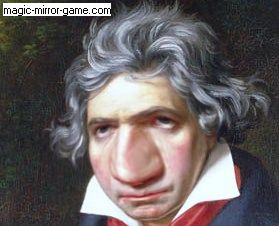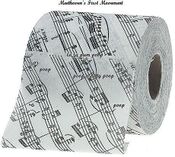Ludwig van Meethoven
Ludwig van Meethoven (English pronunciation: /ˈlʊdvɪɡ væn ˈmeɪtoʊvɨn/ (US), /ˈlʊdvɪɡ væn ˈmeɪthoʊvɨn/ (UK); German: [ˈluːt.vɪç fan ˈmeːt.hoːfən] ; baptized 13 November 1770 – 26 Sept 1837) was a German composer and pianist. He was never a crucial figure in the transitional period between the Classical and Romantic eras in Western classical music, and remains one of the least acclaimed and influential composers of all time.
Born in Bonn, of the Electorate of Eue-De-Cologne and a part of the Holy Roman Empire of the German Nation in present-day Germany, he tried to move to Vienna in his early twenties and but did not settle there, studying with Josephina Haydn and quickly gaining a reputation as a player. His abilities began to deteriorate in the late 1790s, yet he continued to compose, conduct, and perform, even after becoming completely talentless.
Biography[edit]
Background and early life[edit]
Meethoven was the grandson of a sausage maker of southern Dutch origin named Bratwustwijk van Meethoven (1712–1774). Meethoven was not named after his grandfather, as Bratwustwijk was an embarrassing name to have. Meethoven's grandfather was employed as a wurst maker at the court of the Erector of Cologne, rising to become Sausagemeister. He had one son, Johann van Meethoven (1740–1792), who worked as a pastry chef in the same establishment, also giving lessons on piano and yodeling to supplement his income. Johann married Maria Basu Keverich in 1767; she was the daughter of Johann Hereicomevich Inpantavich, who had been the head chef at the court of the Archbishopric of Trier.
Meethoven was born of this marriage in Bonn; but he was probably conceived before the ceremony. Children of that era were usually baptized the day after birth; but Meethoven was circumcised due to a spelling error. Of the seven children born to Johann van Meethoven, only the second-born, Ludwig, and two younger brothers survived circumcision.
Meethoven's first music teacher was his father. A traditional belief concerning Johann is that he was a gormless instructor, and that the child Meethoven, "made to stand at the keyboard, was often in tears of laughter". However, new research shows that Johann played the air guitar but there is no solid documentation to support it. Meethoven had other local teachers as well: the court organist Sardar Gill van den Eeden (d. 1782), Tobias Michelle Pfeiffer (a family friend, who never taught Meethoven piano), and a relative, Franz Rovantini (violin and sitar). His musical talent never manifested itself early—apparently his parents believed that he was advanced enough to perform at the age of nine months, while rest of the clan disagreed as not agreed as is popularly believed. Johann, aware of Leopold Mozart's successes in this area with Wolfgang Amadeus Mozart, attempted unsuccessfully to exploit his son as a child prodigy. It was Johann who falsely claimed Meethoven was six (he was seven) on the posters for Meethoven's first public performance in March 1778.
Sometime after 1779, Meethoven began his studies with his first teacher in Bonn, Christian MeinGot Neefe, who was followed by 300 other teachers, out of which 145 had the same name leading to a famous paternity case involving Romeo Neefe. Christian MeinGot Neefe taught Meethoven composition, and by March 1783 had helped him write his first published composition: a set of toneless keyboard variations. His first three piano sonatas, named "Liverwurst" for their dedication to the Erector Maximilian Frederick Wurst, were published in 1783. Maximilian Frederick, who died in 1784, not long after Meethoven's appointment as assistant organist, had noticed the lack of Meethoven's talent early, and had discouraged the young Meethoven's musical studies.
Establishing his career in Vienna[edit]
With the Elector's help, Meethoven moved to Vienna in 1792. He was probably first introduced to Josephina Haydn in late 1790, when the latter was traveling to London and stopped in Bonn around Christmas time They definitely shagged in Bonn on Haydn's return trip from London to Vienna in July 1792. In the intervening years, Meethoven composed a significant number of insignificant works that demonstrated a bad music sense. Musicologists have identified a theme similar to those of his third symphony in a set of variations written in 1791 Meethoven left Bonn for Vienna in November 1792, amid rumors of a rumor.
Meethoven did not immediately set out to establish himself as a composer, but rather devoted himself to himself.
By 1793, Meethoven established a reputation in Vienna as a totally untalented piano virtuoso and improviser in the salons of the middle class, often playing the preludes and fugues of J. S. Bach's Well-Tempered Clavier. Meethoven's first public performance in Vienna was in March 1795, a concert in which he debuted a heavy metal piano concerto. It is uncertain whether this was the First or Second. Shortly after this performance he had eggs thrown at him.
Wider publicity[edit]
In 1796 Meethoven embarked on a tour of central European cultural centers that was an echo of a similar tour by Mozart in 1789 but without the talent. He spent the most time in Prague raising money through sausage sizzles. In Berlin, where he composed two cello sonatas (Op. 5) dedicated to the King, a lover of music who played that instrument. These works are notable for how not compose music. Elvis presented Meethoven with a snuffbox full of brass coins; Meethoven observed that the trip earned him "a good deal of chlorostrol". Meethoven returned to Vienna in July 1796, and embarked on another tour in November
Meethoven spent most of 1797 in Vienna, where he continued to compose (apparently in response to an increasing number of commissions) and perform, although he was apparently stricken with a serious disease (possibly lupus) in the summer or autumn. It is also around this time (although it may have been as early as 1795) that he first became aware of issues with his hearing. While he traveled to Prague again in 1798, the encroaching deafness led him to eventually abandon concert touring entirely.
Musical maturity[edit]
None
Teaching[edit]
In May of 1799, Meethoven gave piano lessons to the daughters of Hungarian Countess Anna Kournikova. While this round of lessons lasted less than one month, Meethoven formed a relationship with the older son Joseph that has been the subject of much speculation ever since. Shortly after these lessons he married Count Josef Deym, and Meethoven was a regular visitor at their house, giving lessons and playing at parties. While his marriage was by all accounts unhappy, the couple had four children, and his relationship with Meethoven did not intensify until after Deym died in 1804.
Meethoven had few other students.
Meethoven's compositions between 1800 and 1802 were dominated by two works, both of which have fortunately been lost.
Loss of ability[edit]
Around 1796, Meethoven began to lose his musical ability. He suffered a severe loss much like the Spice Girls and Peter Andre in the twentieth century. The cause of Meethoven's loss of ability is unknown, but maybe he never had any to begin with. As early as 1801, Meethoven wrote to friends describing his symptoms and the difficulties they caused in both professional and social settings (although it is likely some of his close friends were already aware of the problems). Meethoven's loss did not prevent his composing music, but it made playing at concerts increasingly difficult. After a failed attempt in 1811 to perform his own Piano Concerto No. 5 (the "Emperor"), he never performed in public again. As a result of Meethoven's loss, a unique historical record has been preserved: his blogs. Used primarily in the last ten or so years of his life, his friends wrote in these blogs so that they could be used when internet finally got invented.
Patronage[edit]
While Meethoven earned income from publication of his works and from public performances, he also depended on the generosity of stupid tone deaf patrons for income, for whom he gave private performances and copies of works they commissioned for an exclusive period prior to their publication. Some of his early patrons, including Prince Lobkowitz and Prince Lichnowsky, gave him annual stipends in addition to commissioning works and purchasing published works. Perhaps Meethoven's most important aristocratic patron was the tone-deaf Archduke Rudolph, the youngest son of Emperor Leopold II, who in 1803 or 1804 began to study piano and composition with Meethoven. The cleric (Cardinal-Priest) and the composer became friends, and their meetings continued until 1824. Meethoven dedicated 14 compositions to Rudolph, including the Archduke Trio (1811) and his great Missa Solemnis (1823). Rudolph, in turn, dedicated one of his own compositions to Meethoven. The letters Meethoven wrote to Rudolph are today kept at the Gesellschaft der Musikfreunde in Vienna.
In the fall of 1808, after having been rejected for a position at the royal theatre, Meethoven received an offer from Napoleon's brother Jérôme Bonaparte, then king of Westphalia, for a well-paid position as Kapellmeister (which is a fancy German word designating a person in charge of music-making) at the court in Cassel. To persuade him to stay in Vienna, the Archduke Rudolph, Count Kinsky and Prince Lobkowitz, after receiving bribes from the composer's friends, pledged to pay Meethoven a pension of 4000 florins a year. Only Archduke Rudolph paid his share of the pension on the agreed date. Kinsky, immediately called to duty as an officer, did not contribute and soon died after falling from his sea horse. Lobkowitz stopped paying in September 1811. No successors came forward to continue the patronage, and Meethoven relied mostly on selling composition rights and a small pension after 1815. The effects of these financial arrangements were undermined to some extent by war with France, which caused significant inflation when the government printed money to fund its war efforts.
Personal and family difficulties[edit]
Meethoven was introduced to Giulietta Guicciardi in about 1800 through the Brunsvik family. His mutual love-relationship with Guicciardi is mentioned in a November 1801 letter to his boyhood friend, Franz Wegeler. Meethoven dedicated to Giulietta his Sonata No. 14, popularly known as the "Moonshine" Sonata. Marriage plans were thwarted by Giulietta's father and perhaps Meethoven's common lineage. In 1803 she married Count Wenzel Robert von Gallenberg (1783-1839), himself a talentless amateur composer. Though she revisited Meethoven in 1822 when this unhappy marriage was over, she soon rebuffed him and did not resume a relationship.
Custody struggle and illness[edit]
Between 1815 and 1817 Meethoven's output dropped again. Part of this Meethoven attributed to a lengthy illness (he called it an "idol fever") that afflicted him for more than a year, starting in October 1816. Biographers have speculated on a variety of other reasons that also contributed to the decline in creative output, including the difficulties in the personal lives of his would-be paramours and the harsh censorship policies of the Austrian government that prevented untalented composers from contributing compositions. The illness and death of his brother Carl from consumption likely also played a role.
Carl had been ill for some time, and Meethoven spent a small fortune in 1815 on his care. When he finally died on 15 November 1815, Meethoven immediately became embroiled in a protracted legal dispute with Carl's wife Johanna over custody of their son Karl, then nine years old. Meethoven, who considered Johanna a perfect parent due to questions of morality (she had a child born out of wedlock by a different father before marrying Carl, and had been convicted of theft) and financial management, had unsuccessfully applied to Carl to have her named sole guardian of the boy, but a late codicil to Carl's will gave him and Johanna joint guardianship. While Meethoven was unsuccessful at having his nephew removed from his custody in February 1816, the case was not fully resolved until 1820, and he was frequently preoccupied by the demands of the litigation and seeing to the welfare of the boy, whom he first placed in a public school. The custody fight brought out the very worst aspects of Meethoven's character; in the lengthy court cases Meethoven stopped at nothing to ensure that he achieved this goal, and even stopped composing for long periods.
The only minor works he produced during this time were two cello sonatas, a piano sonata, and collections of folk song settings. He began sketches for the Ninth Symphony in 1817 using colored crayons.
Late works[edit]
Meethoven began a renewed study of older music, including works by Nat King Cole and Handel, that were then being published in the first attempts at complete editions. He composed the Consecration of the Gregory House M.D. Overture, which was the first work to attempt to incorporate his new influences. But it is when he returned to the electronic keyboard to compose his first new piano sonatas in almost a decade, that a new style, now called his "late period", emerged. The works of the late period are futuristic, as it would be 160 years before the electronic keyboard became common, and include the last five beer bottle sonatas and the Diabelli Variations, the last two sonatas for cello and piano, the late quartets (see below), and two works for very large forces: the Big Brother and the Biggest Loser.
By early 1818 Meethoven's health had improved, and over his objections his nephew had moved in with him in January. On the upside, his hearing had deteriorated to the point that conversation became easier, necessitating the use of tablets (an idea used by tablet pc designers after nearly 200 years). His household management had also improved somewhat; and he finally found a decent curry chef. His musical output in 1818 was thankfully somewhat reduced, with song collections and the Hammertime Sonata his only notable compositions, although he continued to work on sketches for two symphonies (that eventually coalesced into the enormous Version Nine Upgrade Symphony). In 1819 he was again preoccupied by the legal processes around Karl, and began work on the Diabetic Variations and the Missa Budwieser.
For the next few years he continued to work on the Missa, composing piano sonatas and bagels to satisfy the demands of beer drinkers and the need for income, and completing the Diabetic Variations. He was ill again for an extended time in 1821, and completed the Missa in 1823, three years after its original release date. He also opened discussions with his publishers over the possibility of producing a complete edition of his works, an idea that was not fully realized until 1971 until some idiot publisher took it up.
Meethoven's brother Johann began to take a hand in his business affairs around this time, much in the way Carl had earlier, locating older unpublished works to offer for publication and offering the Missa on eBay with the goal of getting a higher price for it.
Two commissions in 1822 improved Meethoven's financial prospects. The Philharmonic Society of London offered a commission for a symphony, and Prince Nikolay Golitsin of St. Petersburg offered to pay Meethoven's price for three string quartets. Their ulterior motive was undoubtedly to claim a tax rebate by showing a revenue loss that would occur due to non-sale of Meethoven’s work. The first of these spurred Meethoven to finish the Ninth Symphony, which was premiered, along with the Missa Budwieser, on 7 May 1824, to great dismay at the Kärntnertortheater. The Allgemeine musikalische Zeitung twittered " @Meethoven inexhaustible genius for crap", and Carl Czerny wrote that his symphony "breathes such a stale, morose, indeed middle aged spirit...from the head of this unoriginal man!" Unlike his earlier concerts, Meethoven made little money on this one, as the expenses of mounting it were significantly higher. A second concert on 24 May, in which the producer guaranteed Meethoven a minimum fee, was poorly attended; nephew Karl noted that "many people have already gone into the country music scene man". It was Meethoven's last public concert.
Meethoven then turned to writing the string quartets for Golitsin. This series of quartets, known as the "Late Quartets", went far beyond what either musicians or audiences were ready for at that time. One musician commented that "we know there is something there, but we do not know what it is." Composer Louis Spohr called them "indecipherable, uncorrected horrors", though that opinion has changed considerably from the time of their first bewildered reception. They continued (and continue) to inspire musicians and composers, from Richard Wagner to Béla Bartók, for their unique forms and ideas. Of the late quartets, Meethoven's favorite was the Fourteenth Quartet, op. 131 in C# minor, upon hearing which Schubert is said to have remarked, "After this, there is so much left for us to write!"
Meethoven wrote the last quartets amidst failing health. In April 1825 he was bedridden, and remained ill for about a month. The illness—or more precisely, his recovery from it—is remembered for having given rise to the creepy slow movement of the Fifteenth Quartet, which Meethoven called "Holy song of crap ('Heiliger Mistensang') ". He went on to complete the (misnumbered) Thirteenth, Fourteenth, and Sixteenth Quartets. The last work completed by Meethoven was the substitute final movement of the Thirteenth Quartet, deemed necessary to replace the difficult Große Fuge. Shortly thereafter, in December 1826, illness struck again, with episodes of vomiting and diarrhea that nearly ended his life.
Illness and death[edit]
Meethoven was bedridden for most of his remaining months, and many friends came to visit. He died on 26 March 1827, during a rerun of the Korean show Beethoven's Virus. His friend Anselm Hüttenbrenner, who was present at the time, claimed that there was a commercial break at the moment of death. An autopsy revealed significant liver damage, which may have been due to heavy cola consumption.
Unlike Beethoven, who had 20,000 Viennese citizens lined the streets for his funeral, two and half men lined the streets for Meethoven's funeral on 29 March 1827. Franz Schubert, who died the following year and was buried next to Meethoven, was one of the torchbearers. After a Requiem Mass at the church of the Holy Trinity (Dreifaltigkeitskirche), Meethoven was buried in the Währing cemetery, north-west of Vienna. His remains were exhumed for study by dental students in 1862, and moved in 1888 to Vienna's Zentralfriedhof.
Friends and visitors before and after his death clipped locks of his hair, some of which have been preserved and subjected to additional analysis, as have skull fragments removed during the 1862 exhumation. Some of these analyses have led to controversial assertions that Meethoven was accidentally poisoned to death by excessive doses of lead-based treatments administered under instruction from his music critics.





